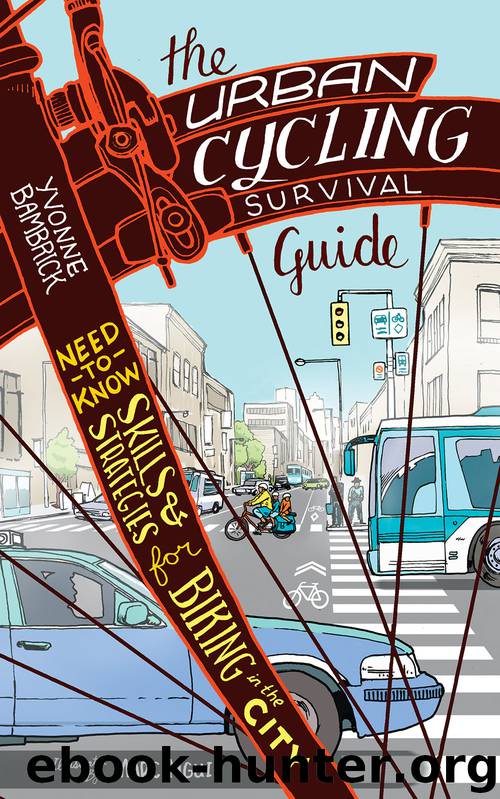The Urban Cycling Survival Guide by Yvonne Bambrick

Author:Yvonne Bambrick [Bambrick, Yvonne]
Language: eng
Format: epub
Tags: Sports; Cycling
Publisher: ECW PRESS
Published: 2015-01-27T20:26:59+00:00
Riding at night can be more hazardous not only because of reduced visibility, but on Friday and Saturday nights in particular, because of inebriated pedestrians and sometimes drivers. While you can come across drunk folks just about anywhere in a city, there are often entertainment districts or streets where a greater concentration of inebriated people can be expected, in particular at closing time when people start to make their way home. When the ball game lets out, for example, it might be smarter not to ride near the stadium — and the unhappy-drunk or happy-drunk fans. Be extra vigilant when watching for pedestrians coming out from between parked cars, stepping off the curb to cross mid-block, or standing in the curb lane to hail a taxi.
ROAD SURFACE CONDITIONS
When you’re out on the road, there’s a lot to keep an eye out for in traffic and on the sidewalk, but watching for changes in the road surface ahead of you is equally important. Remember, if a curb lane is too narrow to safely share with motorists while also avoiding roadside hazards, you are entitled to take the lane.
Debris of all types is usually found at the edge of the road — that very same space bicycles are expected to occupy. Following a heavy rain, grit, dirt, leaves, water, and garbage often accumulate near storm grates and along the edge of the curb. Large puddles are also best avoided since they can hide other hazards, like grates and potholes, and may be deeper than expected.
Uneven pavement, bumps and potholes in the road are the most frequent causes of a fall, crash, or damage to your wheels. Depending on your location in the road, volume of traffic, and other factors, sometimes you can safely and quickly take evasive action around the obstacle. If this isn’t feasible, slow down as much as possible, stand up out of your seat, and use your arms and legs as shock absorbers to avoid a big, heavy hit.
Gravel, grit, and sand in the road are serious hazards for turns in particular. Smaller loose grit can cause you to slip on a turn made with speed, and gravel can also cause a fall by forcing you off balance. Slow down and approach with caution.
Black tar is often used to fill in cracks that develop in the roadway. During the heat of summer, these long strips can become soft and squishy. They can also catch your tires and are best avoided.
Motor oils can accumulate on the roadway during dry, hot periods and then be drawn up to the surface when it rains. If you are caught riding in a rainstorm following a long dry spell, be aware that the road surface may become slick in some places, such as where cars often park in the curb lane.
Piles of slippery, wet autumn leaves can take you down and hide things like grates and potholes. Try to avoid them, and use extra caution on turns in particular. (Read more on riding in ice, rain, and snow.
Download
This site does not store any files on its server. We only index and link to content provided by other sites. Please contact the content providers to delete copyright contents if any and email us, we'll remove relevant links or contents immediately.
Shoe Dog by Phil Knight(5147)
The Rules Do Not Apply by Ariel Levy(4866)
Walking by Henry David Thoreau(3897)
How to Read Water: Clues and Patterns from Puddles to the Sea (Natural Navigation) by Tristan Gooley(3410)
Running Barefoot by Amy Harmon(3398)
I'll Give You the Sun by Jandy Nelson(3362)
Crazy Is My Superpower by A.J. Mendez Brooks(3332)
How to Read Nature by Tristan Gooley(3251)
How Music Works by David Byrne(3191)
The Boy, the Mole, the Fox and the Horse by Charlie Mackesy(3001)
The Fight by Norman Mailer(2849)
Seducing Cinderella by Gina L. Maxwell(2604)
Cuba by Lonely Planet(2579)
Accepted by Pat Patterson(2308)
Going Long by Editors of Runner's World(2298)
The Unfettered Mind: Writings from a Zen Master to a Master Swordsman by Takuan Soho(2249)
The Happy Runner by David Roche(2194)
Backpacker the Complete Guide to Backpacking by Backpacker Magazine(2193)
Trail Magic by Trevelyan Quest Edwards & Hazel Edwards(2127)
